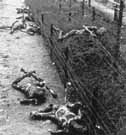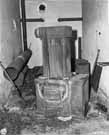
|
|
|

|

|

|

|
|
Click on an image to see a larger, more detailed picture.
|
|
|
|
|
| 1945: Liberation and Rebuilding |

|
pg. 602 |

|
|
|
|
| |
 Jewish women liberated from concentration camps under the Bernadotte Agreement arrive in Malmö, Sweden. One woman reacts with joy in response to the kind person who has offered her a glass of milk. Count Folke Bernadotte arranged the Swedish rescue of nearly 30,000 survivors, mostly from the Ravensbrück concentration camp.
Jewish women liberated from concentration camps under the Bernadotte Agreement arrive in Malmö, Sweden. One woman reacts with joy in response to the kind person who has offered her a glass of milk. Count Folke Bernadotte arranged the Swedish rescue of nearly 30,000 survivors, mostly from the Ravensbrück concentration camp.
Photo: Judiska Kvinnoklubben
|
 U.S. troops discovered these charred bodies when they entered the camp at Thekla, Germany. Margaret Bourke-White, a correspondent for Life magazine, described one of the corpses, that of a professor from Poland, with these words: "The shriveled lower half of his body lay in cinders...with his charred crutch close by, but the fine intellectual bald head thrust through to the outside [of the camp's fence] was still unmarred, with even the spectacles in place. He must have been much loved; the survivors shed many tears over him."
U.S. troops discovered these charred bodies when they entered the camp at Thekla, Germany. Margaret Bourke-White, a correspondent for Life magazine, described one of the corpses, that of a professor from Poland, with these words: "The shriveled lower half of his body lay in cinders...with his charred crutch close by, but the fine intellectual bald head thrust through to the outside [of the camp's fence] was still unmarred, with even the spectacles in place. He must have been much loved; the survivors shed many tears over him."
Photo: Philip Drell
|
 Most smaller camps employed diesel-powered engines to create the gas used to murder their victims, but the Nazis often improvised (above) to carry out their grisly tasks.
Most smaller camps employed diesel-powered engines to create the gas used to murder their victims, but the Nazis often improvised (above) to carry out their grisly tasks.
Photo: National Archives/United States Holocaust Memorial Museum Photo Archive
|
|

|

|

|

|
 April 4, 1945: Jews toiling in quarries at Gotha, Germany, are murdered by their Nazi overseers.
April 4, 1945: Jews toiling in quarries at Gotha, Germany, are murdered by their Nazi overseers.
|
 April 8, 1945: Jewish inmates are marched out of the concentration camp at Buchenwald, Germany, to the camp at Flossenbürg, Germany, 100 miles to the southeast. Non-Jewish prisoners are left behind to await the advancing Americans. A few Jews are able to hide and avoid the march; See April 11, 1945.
April 8, 1945: Jewish inmates are marched out of the concentration camp at Buchenwald, Germany, to the camp at Flossenbürg, Germany, 100 miles to the southeast. Non-Jewish prisoners are left behind to await the advancing Americans. A few Jews are able to hide and avoid the march; See April 11, 1945.
|
|
|
|
|
| 1945: Liberation and Rebuilding |

|
pg. 602 |

|
|
The Holocaust Chronicle
© 2009 Publications International, Ltd.
|
|
